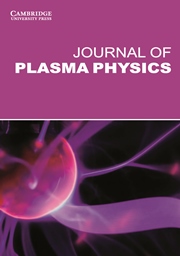Article contents
Hydrodynamics of quantum corrections to the Coulomb interaction via the third rank tensor evolution equation: application to Langmuir waves and spin-electron acoustic waves
Published online by Cambridge University Press: 04 November 2021
Abstract
The quantum effects in plasmas can be described by the hydrodynamics containing the continuity and Euler equations. However, novel quantum phenomena are found via the extended set of hydrodynamic equations, where the pressure evolution equation and the pressure flux third-rank tensor evolution equation are included. These give the quantum corrections to the Coulomb interaction. The spectra of the Langmuir waves and the spin-electron acoustic waves are calculated. The application of the pressure evolution equation ensures that the contribution of pressure in the Langmuir wave spectrum is proportional to $(3/5)v_{\textrm {Fe}}^{2}$ rather than $(1/3)v_{\textrm {Fe}}^{2}$
rather than $(1/3)v_{\textrm {Fe}}^{2}$ , where $v_{\textrm {Fe}}$
, where $v_{\textrm {Fe}}$ is the Fermi velocity.
is the Fermi velocity.
Information
- Type
- Research Article
- Information
- Copyright
- Copyright © The Author(s), 2021. Published by Cambridge University Press
References
REFERENCES
- 9
- Cited by


